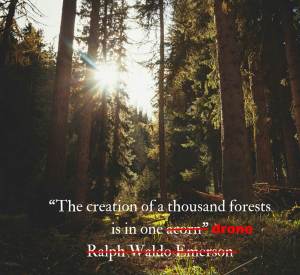Here’s a new idea under the sun… tree-planting drones.
Take a minute and think about all of the forest products you use in a day. I’m sitting on one right now as is my laptop. Anyone who’s bought school supplies in the last weeks has also consumed a fair amount. As an avid list-maker, I use my fair share of small pieces of paper for reminders and tasks to be done. Of course, let’s not forget the oxygen. The U.S. Forest Service estimates that forest products account for 4.5% of the total U.S. manufacturing gross domestic product at $190 billion in products annually and employing >900,000 people. There’s little room for doubt, forests are valuable both as they stand and as they fall.
I’ve mentioned before that numbers are important. In this context, numbers about forests can be extremely valuable. New research in Nature this week gives a new estimate of our global tree density. The good news… The earth has nearly an order of magnitude more trees than previously estimated by satellite imagery. The research team puts the total number of trees on the planet at 3.04 trillion. That’s more than 400 trees per person. To you, these numbers are likely just interesting statistics to impress your friends, but to scientists, conservationists and the forestry industry the new estimates of tree density are important for guiding management policies.
The new estimate is based on more than 400,000 ‘ground-sourced measurements of tree density from every continent except Antarctica.’ Translation: A lot of man-hours were spent by humans in a forest collecting tree density data. Of course, the team wasn’t able to count each and every tree, but this is more accurate data than estimating tree numbers from space. Check out the video below for a great data visualization of the world’s forests based on this new research.
If you were paying attention, forest numbers are not static. For various reasons around the globe forests are declining. Current estimates give a net loss of 10 billion trees a year. Some of this loss is due to forest fires, but for decades the forestry industry has become increasingly mechanized to efficiently harvest trees for all of those useful forest products. On the other side of the equation, replanting new trees has not experienced the same industrialization and relies heavily on meticulous man hours and dirty hands. The company BioCarbon Engineering seeks to change this and offers a new scalable model for planting trees using drones. Yes, drones for a noble purpose. The drones are engineered to shoot bullets wrapped in a biodegradable casing and containing soil with pre-germinated seeds into the ground. This could be used for replanting after forest fires or in other areas where forests need help with recovery.
They estimate that they can scale up to 1 billion trees per year. It greatly decreases the amount of human hours involved compared to hand-planting. It’s also more efficient relative to mass seeding because the seeds are pre-germinated, which will eliminate the loss due to bad seeds. The numbers are still not yet in the trees’ favor, but closing the gap with deforestation is a step in the right direction and the Lorax would be proud.
Johnna
*Of course, BioCarbon Engineering could always enter into a relationship with that BIOS Urn company that uses your cremated ashes as the germination medium for tree seeds. Then you and your loved ones could have your ashes with tree seedlings shot almost anywhere to make a stand of trees somewhere in the wilderness rather than just one tree at a time with a single urn. But as I’ve mentioned before, that’s not exactly how photosynthesis and the carbon cycle works.
//The blog has been dark for a record length of time. Only for lack of time and not material. Regularly scheduled posts coming soon.
References and Links:
http://www.nature.com/nature/journal/vaop/ncurrent/full/nature14967.html
http://www.nature.com/news/global-count-reaches-3-trillion-trees-1.18287
For more on the tree-counting research, check out this post over at The Quiet Branches blog.
http://www.biocarbonengineering.com/
http://www.biocarbonengineering.com/blog/deforestation
http://www.biocarbonengineering.com/blog/deforestation-data
http://www.biocarbonengineering.com/blog/what-is-the-social-value-of-a-tree
http://www.msnbc.com/greenhouse/watch/using-drones-to-improve-reforestation-445645891970













